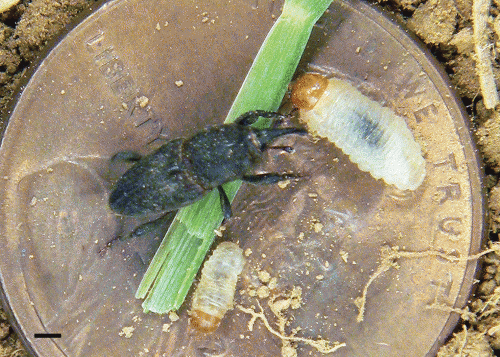This shows two billbug (Sphenophorus spp.) larvae (right and bottom) and bluegrass billbug (S. parvulus) adult (center) on the head of a penny. Scale bar = 1 mm. Credit: Entomological Society of America
Two weevil species, the bluegrass billbug and the hunting billbug, have caused widespread economic damage to orchardgrass, a cool season grass that is cultivated throughout the United States as a high-value forage crop.
The cryptic feeding habits of these species, combined with a lack of effective systemic insecticides, make billbug control extremely difficult in orchardgrass. However, a new article in the open-access Journal of Integrated Pest Management called "Ecology, Taxonomy, and Pest Management of Billbugs (Coleoptera: Curculionidae) in Orchardgrass of Virginia" presents an overview of the biology of orchardgrass and its associated billbug pests, and reviews the control options for these pests.
Described by Linnaeus in 1753, orchardgrass is a cool season bunchgrass used for forage throughout the world. Billbug feeding can destroy orchardgrass, depending on the size of the billbug population and weather conditions. In addition to causing direct injury to the plant, feeding can also provide the opportunity for infection by rot-inducing bacteria and fungi.
Although a number of cultural, biological, and chemical control methods have been suggested for billbugs in turfgrass and corn, there has been little focus on control in orchardgrass. Therefore, further investigations are warranted to verify the life histories of the bluegrass and hunting billbugs on orchardgrass, and feeding studies are needed to determine whether these species regularly feed on orchardgrass and, if so, how likely they are to become pests. Finally, the current measures available for control of billbugs in orchardgrass are extremely limited. New management tools, insecticides or otherwise, are required to effectively control this pest.
More information: esa.publisher.ingentaconnect.c … 04/00000003/art00002
Provided by Entomological Society of America
























